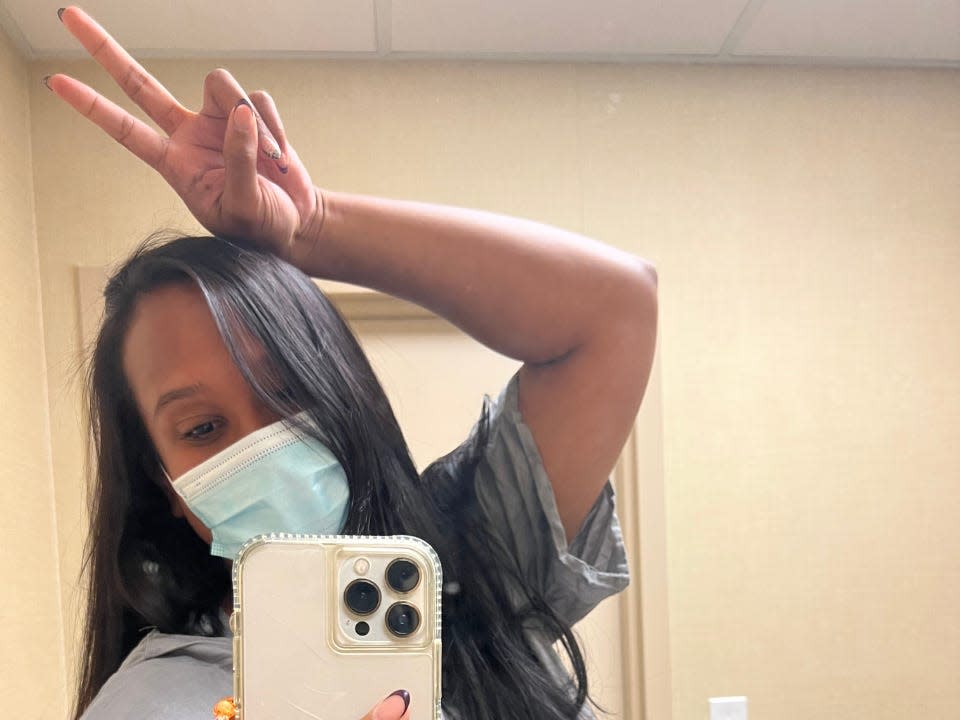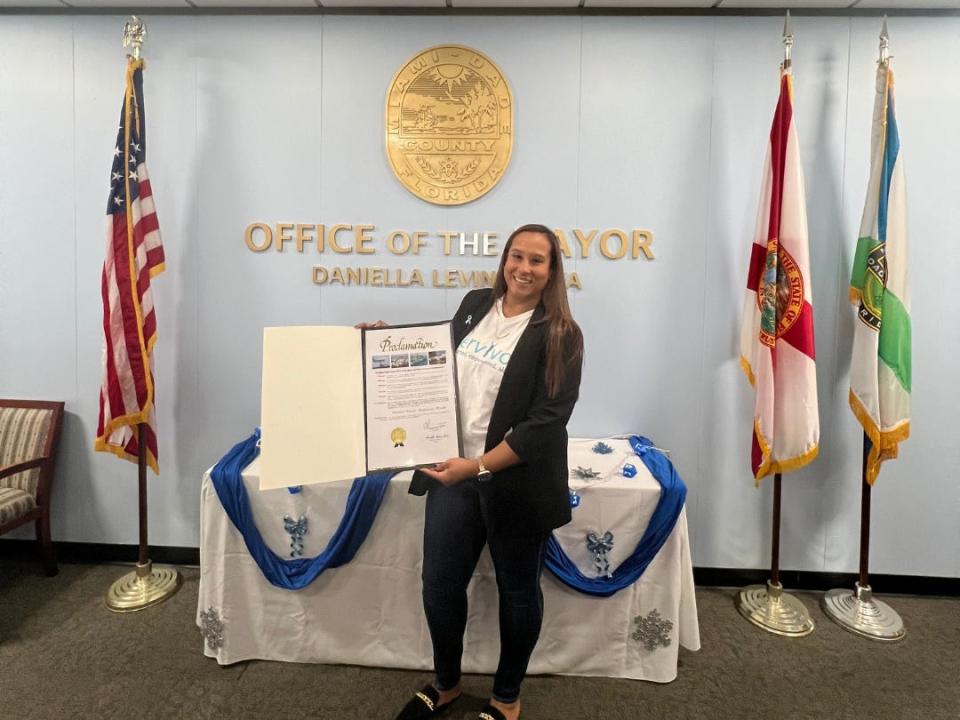A woman with unexplained bleeding felt dismissed by her gynecologist. She swapped doctors and was diagnosed with cervical cancer.
Avi Grant-Noonan had abnormal bleeding and irregular periods.
She ignored what turned out to be the symptoms of stage three cervical cancer.
Two pap smears failed to identify her yearslong HPV infection.
After Avi Grant-Noonan had her daughter in 2007, she noticed she was missing periods for months at a time, and had started bleeding on and off.
Her symptoms lasted for years, but her gynecologist told her not to worry and made Grant-Noonan feel like she was overreacting. So she put them to the back of her mind and focused on looking after her daughter, who has special needs.
“I put my own health on the back burner,” Grant-Noonan, a 38-year-old market planning analyst from Honduras who now lives in Miami, told Business Insider. “But at the time, I didn’t want more kids, so it was fine.”
During this period, Grant-Noonan missed a few routine pap smears, which screen for cervical cancer. When she suddenly dropped around 80 pounds in six months between 2017 and 2018, she put it down to the fact she had started running twice a day.
But Grant-Noonan was forced to prioritize her health when she miscarried in 2019, four months into her second pregnancy. She and her husband had started trying for another baby in 2017 and were surprised when they struggled because she was only 32 and had already had a child.
“My body was kind of letting me know, hey, you need to figure out what's going on,” she said.
Grant-Noonan suspected the symptoms she’d put to the back of her mind offered a clue to what was wrong.
“I was like, ‘I don't feel right, there's something going on,'" she said. “That's pretty much when my journey started with cancer.”
In 2021, at the age of 34, 14 years after her abnormal bleeding first started, Grant-Noonan was diagnosed with stage three cervical cancer.
Eliminating cervical cancer with vaccines
Rates of cervical cancer are dropping thanks to the roll-out of vaccines in pre-teens against the human papillomavirus that causes the majority of cases, with the World Health Organization aiming to eliminate the disease by the end of the century. But people like Grant-Noonan — who was 20 years old in 2006 when HPV vaccines were first given to 11 to 12-year-olds as part of routine childhood vaccination in the US — have fallen through the cracks.
Grant-Noonan said she wants to share her story to raise awareness of the disease, to encourage people to vaccinate themselves and their children against HPV, and to advocate for themselves at the doctor’s office.
“Take the time to go to your doctor if you think something is wrong,” she said. “And speak up and advocate for yourself because you know your body better than anybody.”
“Cervical cancer is a silent killer, and you don't know you have it until it's too late. So if, with my story, I can save one life, I think I've done my mission in this world,” she said.
Grant-Noonan says her symptoms weren’t taken seriously
Grant-Noonan wondered if her first gynecologist, who dismissed her symptoms, thought she was exaggerating because she is Hispanic, or assumed she was too young to have cervical cancer. Her hunch chimes with research suggesting most physicians in the US hold some level of implicit bias against Hispanic and Latino people, comparable to that experienced by Black people.
She decided it was time to switch doctors and she found a new gynecologist who tried to help her figure out what was wrong, performing two pap smears in 2020. But they came back negative, which can happen if the swab only picks up normal cells or doesn’t pick up enough abnormal cells.
In 2021, the gynecologist did a colposcopy, where the vagina is examined under a magnifying instrument to spot areas of suspicious cells. From this, he was able to diagnose Grant-Noonan with cervical cancer.

Almost all cases of cervical cancer, including Grant-Noonan’s, are caused by a long-lasting HPV infection. HPV is spread via vaginal, anal, or oral sex, making vaccination less effective in adults who are more likely to have been exposed to the virus through sexual activity.
However, those unvaccinated against HPV remain at risk of developing multiple cancers — such as vulvar, penile, anal, and vaginal — even if they’ve already had cancer caused by the virus. The Centers for Disease Control and Prevention advises older people who want the vaccine to speak to their doctor, as it says it isn’t necessary for everyone over 26.
Grant-Noonan had an undiagnosed HPV infection for years, which developed into cervical cancer
A HPV infection can trigger changes in the genes of cells that line the cervix or the opening to the uterus, and make them grow uncontrollably and develop into cancer.
This process can take 10 to fifteen years, as was Grant-Noonan’s experience. During this period, people don’t tend to experience symptoms, which is why cervical screenings are important to identify precancerous cells.
Symptoms that can occur once the cancer has spread include vaginal bleeding after sex and between periods, and periods that are heavier or longer than normal. Once the cancer has advanced, symptoms can include difficulty or pain when pooping and peeing, blood in pee or bleeding from the rectum, back or abdomen pain, swelling in the legs, and feeling tired.
Grant-Noonan's gynecologist said her symptoms were likely caused by cancer, but said her miscarriage wasn't.

Spreading awareness of cervical cancer gives Grant-Noonan a sense of purpose
Once she was diagnosed, Grant-Noonan saw a gynecological oncologist within two weeks.
“It moved really fast. I went in for a PET scan, an MRI, and a CT scan to figure out exactly what stage I was in. At first, he thought it was stage one, and I was like, ‘Oh, perfect. We caught it early.’ But actually, I was at stage three,” she said.
Cervical cancer has a 91% five-year survival rate from diagnosis if treatment starts when the cancer hasn’t yet spread to other organs, dropping to 19% if it has. Grant-Noonan was at stage three, meaning the cancer had spread to the tissue around the cervix in the vagina and the pelvic wall.
The speed at which her cancer needed to be treated meant she was unable to preserve her eggs. “To know at 35 that I was going to lose my fertility hit me really hard,” she said.

Grant-Noonan had four rounds of chemotherapy, 52 rounds of external radiation, and five rounds of internal radiation, known as brachytherapy — which, for cervical cancer, involves putting a radiation source in the vagina.
Grant-Noonan described brachytherapy as “the most brutal and barbaric thing out there.”
Her treatment took three months and ended on November 5, 2021. When she returned for a PET scan in January 2022, doctors found no evidence of disease, and she has remained in remission for two years.
Educating people about cervical cancer and how to prevent it through her involvement with Cervivor, a nonprofit network of cervical cancer survivors, has given Grant-Noonan a sense of purpose, she said.
“Life gets crazy at times because we all have work, significant others, kids, pets. But your health should come first at the end of the day because once you get sick, the world stops. So schedule your pap smear, schedule your yearly physicals, don't miss any of those exams,” she said.
Read the original article on Business Insider


